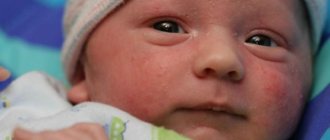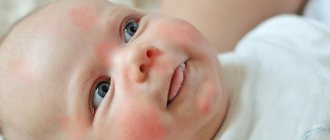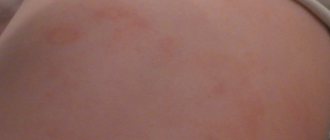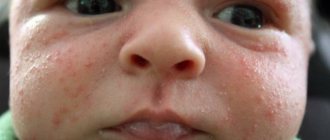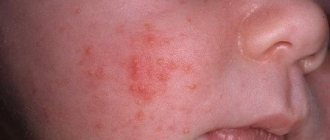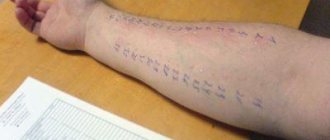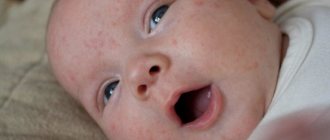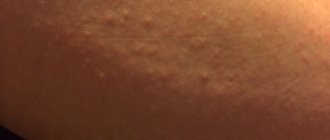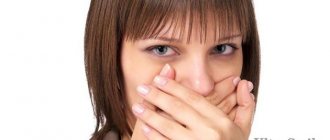Good afternoon, young parents! Today we will talk about white dots on the face of a newborn - what are they? When parents first experience the joy of a new person coming into this world, whom they had already fallen in love with when he was still living and developing in the womb, they still do not know how many difficulties and new discoveries await them ahead.
The first feeding, the first diaper change and other joyful moments of caring for a child - all this causes conflicting feelings in mothers.
On the one hand, the woman feels her heart overflowing with love for the baby and the desire to take care of the baby, and on the other hand, they feel a painful fear that they will cause the child some kind of pain. There will be many more such fears.
One of the reasons for parents' concern and concerns about the baby's health is white spots on the face of the newborn.
- Is it worth worrying and sounding the alarm about this?
- Where do these whiteheads come from and how to treat them?
Causes
Infants' skin copes poorly with thermoregulation and sweating. It contains so little melanin (pigment) that it is defenseless against UV radiation. A low barrier index allows access to pathogens.
There are many factors influencing inflammation of the skin in newborns under 28 days of age:
- unsettled hormonal balance;
- weak resistance of the skin and internal organs to irritating factors;
- incomplete colonization of the intestines with beneficial bacteria;
- inability to adapt to weather and climatic conditions.
The source of acne can be one or a combination of reasons . It is important to correctly determine the mechanism of the appearance of rashes. The adequacy of the response will depend on this - whether to carry out treatment, or simply wait until the body copes with the problem itself.
Hormonal disorders
For babies who have recently left their mother’s womb, some hormonal “leapfrog” is typical. The hormones of the pregnant mother are still present in their blood, and hormones from breast milk are added to them, and all this against the background of their own unformed balance. Often there is an excess of hormones, and the small body responds with rashes.
Pimples on a newborn's face can accumulate into red areas of roughness and increased fat content. When bacteria get on them, pustules form. Similar formations on the chin, cheeks, and forehead are possible in the 3rd week. Sometimes they spread to the neck, ears, back, chest, and pubescent part of the head. In most cases, the skin clears itself by about 1.5 months.
Allergy
A nursing mother who does not observe restrictions in her diet, use of medications, creams, shampoos and cosmetics will become a daily source of irritating substances in her milk. Since the infant’s body is unable to cope with them, a painful reaction occurs - an allergy and the small red rashes that accompany it.
Irritants include:
- sweets, citrus fruits, red berries, new foods in the mother’s diet;
- unsuitable formula for artificial feeding;
- medicines;
- detergents for washing diapers and vests;
- cosmetics;
- animals, plants;
- home and street dust.
An allergic reaction that is not stopped in time can turn local small pimples into a generalized rash (over the entire body).
Dysbacteriosis
A violation of the ratio of microorganisms in the intestinal tract is dangerous even for an adult, and doubly so for an infant. His sterile intestines are only slightly populated by lactoflora during the passage of the birth canal. In the future, Nature relies on breast milk, which is rich in substances that support the growth of beneficial bacteria and inhibit harmful ones.
In babies who receive maternal nutrition, dysbacteriosis is practically absent and strong immunity is formed. The risk group includes children born surgically, as well as those who are artificially fed. Their poor microbial landscape leads to bloating, colic, and problems with bowel movements. This cannot but affect the skin with redness and rashes.
Untreated dysbiosis does not contribute to the accumulation of beneficial flora and will ultimately lead to severe disruption of water and electrolyte balance.
Response to climate change
In babies of the early postnatal period, isolated red pimples on the face may occur after being on a cold street. The skin is not yet accustomed to the low temperature, but it is a matter of time.
Climate change brings more stress. There may be 2 options here - either the skin will heal itself after acclimatization, or the new conditions are categorically unsuitable for a small organism and you need to move. This is especially true for regions with poor ecology.
Infectious causes
Inflammatory processes on the skin can occur under the influence of viral diseases:
- herpes (chickenpox, roseola)
- enterovirus;
- scarlet fever;
- measles;
- rubella;
- meningitis.
Each type of infection manifests itself differently, both visually and in terms of its individual course. Parents should not rely on their fragmentary medical knowledge, but urgently show the baby to a pediatrician.
Useful tips for parents on caring for their children's skin when whiteheads appear
If you notice any changes in the skin, rash or peeling in your newborn baby, the first thing to do is calm down and don’t panic! Ideal newborn babies with the purest peach skin exist only in Photoshop.
Therefore, there is no need to be afraid that something terrible is happening to your baby. This is only a temporary phenomenon, which, with proper care, will pass very quickly. But, you are able to speed up the process of cleansing your baby’s skin, so arm yourself with tips and act.
- Be sure to consult with your doctor before concluding that your child's pimples are not dangerous and do not require additional treatment.
- Wash your baby daily - twice a day, morning and evening. For washing, use only warm boiled water or saline solution. Under no circumstances should you wash your baby with raw or artesian water - there are a lot of bacteria and salts there that will negatively affect the condition of delicate skin.
- In principle, you can also use herbal decoctions for washing, but when choosing a specific plant, be sure to consult your doctor.
- Never treat whiteheads on your newborn's face with alcohol, hydrogen peroxide, or any alcohol-based lotion. Baby skin is too delicate and you can burn it very easily.
- Do not squeeze or tear off the white dots - this will not speed up recovery, it can only cause infection.
- Make sure that the baby does not pick off these pimples, and trim his nails on time.
- Do not use any rash or acne treatment that is intended for adults. The skin of an adult and a newborn is very different.
White dots on the face of a newborn are considered to be a sign of early infancy, don’t worry!
Types of acne in babies
Pimples on a newborn's face can be red and white, small and large, single and in the form of a rash of varying density. They nest in separate areas or completely cover the front area.
White
“Millet grains” – milia – are white or yellowish-white. They are formed due to blockage of the mouth of the sebaceous glands on the nose, forehead, and cheeks. Such fatty deposits are full of hardened sebaceous secretions. This is one of the reactions of the adaptation period.
Milia does not require treatment. Most 3-month-old babies no longer have them. Parents need to try to prevent scratches, abrasions, and tearing of the millet. Microtraumas can lead to contamination with pyogenic bacteria, and after healing, the formation of a concave scar.
White-yellowish tubercles are characteristic of toxic erythema. It manifests itself with varying intensity in almost half of infants on days 2-4. The culprits of erythema are active substances involved in the allergic reaction of adaptation to the environment.
Reasons include:
- hereditary (genetic) factors, including endocrine profile;
- harmful working conditions of the mother;
- toxicosis during pregnancy;
- penetration of drugs through the placenta;
- hypoxia, fetal infection;
- delayed by 6-12 hours. first breastfeeding.
The baby's skin becomes covered with dense red spots, with light bumps in the center. Treatment is required only for the generalized form.
Reds
Red rashes in the early postnatal period provoke:
- Herpes infection. The first phase of chickenpox can be distinguished by severe itching, the transformation of small pimples into watery blisters on the face and any other part of the body.
Pimples on the face and body of a newborn on the face can be caused by a disease such as chicken pox - Diaper rash. Local inflammation occurs behind the ears, in the folds of the neck due to overheating, sweating, and rubbing with clothing. The skin is damp and flaky, but may remain dry. Neglected foci of redness turn into pimples with a tendency to fungal, bacterial infection and suppuration. Since the distances from the neck, ears to the face are microscopic, irritation also appears on it. Diaper rash is more often observed in fair-skinned, overweight children, with diathesis, allergies, and endocrine problems.
- Fungal infection. A child can be infected with opportunistic fungi such as Candida by: a woman in labor who has not treated vaginal thrush; a nursing mother who has candidiasis in the mammary glands; other carriers of the fungus in contact with the baby. Unprotected skin and antibiotic treatment predispose to the disease. Multiple small red papules around the mouth and on the lips gradually unite into large lesions surrounded by blisters. It will not take long to spread into the oral cavity. Seeking medical help can stop the infection at an early stage. Otherwise, the respiratory, digestive tract and immunity suffer.
- Allergic dermatitis. Foci of diathesis appear in infants, regardless of the type of feeding. An itchy, small scarlet rash on the chin and cheeks indicates disturbances in metabolic and nervous processes, unsatisfactory functioning of internal organs, and an allergic response to irritants ingested with food, air, or through the skin.
- Rubella. As a result of the introduction of the virus, the skin of the face and other parts of the body becomes covered with flat pimples. A mother who has had rubella for a long time gives her child antibodies. An ill pregnant woman is highly likely to infect the fetus, and the virus will cause developmental defects. Congenital and acquired rubella causes a local rash. To avoid serious complications, immediate treatment is required.
- Scabies. The infectious disease comes from scabies mites through infected clothing, toys, and hands. Female parasites drill deep passages between layers of skin to lay eggs. Further colonization by hatching generations of ticks proceeds non-stop. Intoxication and body responses lead to the appearance of an inflamed itchy rash on the face, head, and hands. Redness and ulcers are the easiest thing a baby has to endure. Only quickly applied treatment will relieve him of parasites and serious consequences.
Large
Large pimples can be a manifestation of infection, dermatitis:
- Advanced food, contact and neuroallergies can cause swelling of large, itchy pimples and blisters.
- With eczematous inflammation of the skin, pink-red papules (nodules) appear on the face. Polymorphic (visually different) tubercles flake, itch very much and over time turn into large areas of weeping. The released serous exudate dries into a crust. Eczema occurs when the body is acutely sensitive to allergens of food, chemical, bacterial, and parasitic groups. With timely treatment, it is possible to avoid the transition to a chronic form.
- Large areas of redness occur due to non-food atopic dermatitis. The period of its active manifestation is up to 2 years of age. The disease is not contagious and can be easily treated. When combined with preventive measures, complete recovery occurs by approximately 5 years of age. Ignoring professional treatment is fraught with a transition to a chronic course throughout life. The causes are considered to be heredity, climate, ecology, and skin characteristics. A red and later purulent rash occupies the folds, but the face is not protected from it. If acne appears more than a day after what is suspected to be inappropriate feeding, it is most likely atopic dermatitis.
- Pyogenic cocci form large cavities with purulent filling on the chin, neck, and head, surrounded by a red ring. If signs of pyoderma are detected in a child, parents should literally fly to the doctor. If tests show the presence of cocci, treatment should be started without delay. There is a risk of the addition of Staphylococcus aureus, boils, deeper carbuncles, impetigo (scabs), ulcers, as well as lichen in the form of large red spots with active peeling and itching.
Prickly heat
Acne from excessive wrapping and sweating looks like a small rash against a red spot. Later bubbles form. Scratching them leads to weeping and suppuration. Miliaria is localized in places of contact with clothing and bedding. It is easy to get rid of the first signs of prickly heat by airing the baby’s skin and wearing clothes appropriate for the weather. In advanced situations, the doctor prescribes treatment.
Symptoms of prickly heat in children:
What to do if your baby has white spots on his face
Parents accept the birth of a long-awaited baby as a miracle. The state of his health is the first topic of conversation with the doctor. I would like the baby to be healthy, develop according to his age, not get sick, sleep well and eat with appetite.
Therefore, any unknown appearance on the baby’s skin worries adults very much, especially if they are white dots. What are these formations and what needs to be done to make them disappear?
Causes of white dots
The doctor is in a hurry to reassure new parents that there is no reason for concern in this situation. And he's right. Because this is a common phenomenon that many mothers and fathers have to deal with.
Restructuring of the hormonal system. While the baby was in the womb, nutrition occurred through the umbilical cord connecting the body of mother and child. Some of the maternal hormones entered the baby’s blood. During childbirth, the obstetrician cuts the umbilical cord. Now the baby will receive nutrients through mother's milk.
Hormonal imbalance provokes the appearance of white dots, which most often form on the face. The next reason follows from this.
Excessive amounts of estriol, a female hormone. If an excess amount accumulates in the baby’s body, the internal systems receive a command to remove it, including through the skin pores. These can be single or multiple tiny acne, “scattered” over the baby’s body.
Formation of sebaceous glands. The child's body adapts to life in external conditions. The sebaceous glands are still imperfect and it takes time for them to start working properly. And after the birth of the baby, they can become clogged with excess sebaceous secretions, which look like a white “scattering” on the forehead, cheeks, and wings of the nose.
Milia (milia) are so small that when looking at them, an analogy arises in the mind with tiny grains of sand or sugar crystals. Don't worry about the baby's condition. After a month, the sebaceous glands will be fully formed and the white formations will disappear.
You should not interfere with the natural processes that the child’s body itself regulates. Parents should only monitor his general condition: whether his body temperature has risen, whether he has lost his appetite and sound sleep. It is better not to touch tiny pimples on the face at this time.
Diagnostics
Not every parent will be able to calmly observe the appearance of unusual neoplasms on the child’s body. The natural reaction in this case is to understand what is happening to the precious child and take the right measures.
Important! If the rashes do not disappear for a long time, it is time to sound the alarm. Consultation with a specialist will clarify the situation.
For this purpose it is prescribed:
- Dermoscopy of skin rashes;
- pH-metry of the skin.
The doctor will choose the right direction of treatment and give competent recommendations on further actions.
Symptoms
In a newborn, papules with white-pearly or yellowish contents appear, as a rule, a few days after birth and disappear after a short time - within a few days or weeks.
White pimples are often multiple in nature, but can occur singly. Don't worry ahead of time.
But in any case, you need to see a doctor to figure out what is happening to the baby.
What should I do?
Babies express their discomfort by crying loudly. Their needs in the first months are minimal: they want to eat and sleep. And only after a few weeks they begin to show active interest in the world around them. By crying loudly, the baby gives a signal to mommy that he is wet and dirty. He is cold and uncomfortable in dirty diapers.
Timely hygiene procedures are the main thing that parents should do to ensure that whiteheads disappear quickly and without complications.
Areas of accumulation of dots can be wiped daily with a weak furatsilin solution, and the baby himself must be bathed in warm water, to which decoctions of medicinal herbs have been added: string, calendula, chamomile, etc. You can also add a little potassium permanganate to the water.
The important thing here is not to overdo it. The water should have a faint pink tint. Otherwise, the baby may get burned!
What not to do?
Precautionary measures strictly observed by parents will help avoid unpleasant moments in the future.
Remember these simple rules and recommendations:
- In the first 2 months of life, it is better not to use soap during bathing;
- Sometimes adults make a big mistake by trying to squeeze out white pimples on their own. Doing this is strictly prohibited, because small wounds can easily become infected;
- Do not wipe acne areas with alcohol-containing liquids. This can cause severe irritation on delicate skin;
- You need to make sure that the baby doesn’t accidentally hurt himself by waving his arms in different directions. In the first days of life, babies cannot control the movement of their limbs. If you don’t want to tightly swaddle your baby in a diaper, then there should be special “mittens” made of soft fabric on the arms.
The baby needs to be bathed daily, thoroughly rinsing body folds and hard-to-reach areas with warm water. This measure is enough for the white dots to disappear in a short time. There is no need to use any creams, lotions or detergents.
Preventive actions
The health of the baby depends on the mother’s well-being. If she is unhealthy, eats poorly, is unwell, then this will immediately affect the quality of breast milk. The baby will eat reluctantly, or he will lose his appetite altogether. The saddest thing in such situations is when the baby refuses mother's milk.
Therefore, it is important to strictly follow your doctor's recommendations. The diet should contain healthy and fresh foods that improve lactation. Of course, when a child is restless and very active, you won’t get much sleep, but you still need to try to devote as much time as possible to rest.
Frequent walks in the fresh air have a beneficial effect on both the health of the baby and the well-being of the mother. You should not wrap your baby too much. This can cause prickly heat.
In any case, if adults notice white spots, you should definitely consult a doctor who will give competent recommendations on further actions.
Recommended video to watch:
The child’s body is very fragile and does not tolerate rough interference and questionable methods of treatment, because of which the baby’s health can suffer greatly.
1litso.ru
Fighting methods
It is impossible to hide from viral and bacterial infections. Parents can only not miss the onset of the disease and quickly take the baby to the doctor.
Pimples on a newborn's face, such as prickly heat, diaper rash, and some types of allergies, can be overcome on your own:
- organizing adequate nutrition for a nursing mother;
- correct selection of powdered milk;
- Constantly maintaining the baby's skin clean and dry.
The menu for the lactation period must take into account the needs of the mother’s body for postpartum recovery and milk reproduction, as well as the allergic sensitivity of the child’s body.
The table shows allergenic foods and examples of healthy dishes:
| It is forbidden | Can |
| fruits of tropical plants |
|
| spicy, spicy seasonings | soups – vegetable, cauliflower with cheese, vegetable broth with meatballs, chicken, fish soup |
| egg white, canned food, semi-finished products, animal fat |
|
| honey | almonds 5-6 pcs. |
| homemade confectionery products and especially store-bought ones with harmful artificial ingredients |
|
| chocolate | cereal porridge |
| coffee | limited tea with milk, cocoa |
| alcohol in all types | milk, kefir, yogurt, caramel milk, yogurt, sour cream, compote, jelly |
Advice to mom: do not take dietary restrictions to the point of fanaticism; first you should find out the cause of the child’s rash reaction.
Artificial feeding should take place under the control of the baby’s well-being. If dry formula doesn't suit him, it will show during the day. There is no need to rely on gradual addiction; it is better to immediately try another milk substitute. Although the reaction can be to simple overeating.
Naked sun and air baths are beneficial. They are carried out before water procedures.
Bathing is an important point in hygiene and treatment. Boiled water must be poured into the disinfected font. It is preferable to add homemade herbal infusions of chamomile, string or a weak solution of manganese to it. In the 5 minutes allotted to the little ones, it is necessary for the healing water to fall on the head and face.
Finally, the baby is carefully but thoroughly blotted with a soft towel and caring creams, oils, and medicinal products are applied to dry skin. In addition to bathing, the baby is also washed during the day so that no traces of feeding or other contaminants remain on the face.
For washing, individually selected special baby powders and white baby soap are used. It’s okay if the stains don’t come off, it’s important that the baby is healthy.
In a newborn's room, it is necessary to regulate the air condition, avoiding excessive heat, dryness or cold, dampness. The number and density of diapers must correspond to the ambient temperature. You should not “imprison” your baby in diapers. They make care easier, but when warm they lead to overheating, which affects the whole body.
Pustules on the body
The formation of pustules on the body and face of a baby can be a rather alarming symptom and a natural condition that does not require targeted treatment. So, such pimples can appear due to:
- Hormonal fluctuations. When a baby has recently been born, his mother’s hormones are still in his blood, and his own endocrine system is just learning to work correctly. The processes of elimination of maternal hormones may be accompanied by the formation of small pustules and acne. Such acne does not bother the baby at all.
- Toxic erythema. We talked about this state a little higher. If it is generalized, then the baby’s body may become covered with many rashes and pustules. At the same time, the baby’s condition worsens, the rash brings discomfort, and the temperature increases.
- Attacks of various bacteria. When pathological pustules appear, the skin around them appears swollen and red. The blisters can grow and burst, resulting in the formation of ulcers and erosions on the baby’s body. A bacterial rash requires targeted treatment under the supervision of a doctor.
Most often, pustules on the body of infants occur due to natural hormonal processes in the body and go away quite quickly. But only a doctor can accurately determine the cause of their appearance.
Treatment with pharmaceutical drugs
Pharmacy displays offer a wide range of baby creams and oils with caring and medicinal properties. It is better to choose well-known brands that use approved, mainly natural ingredients.
Pimples on a newborn's face will quickly go away if you use age-appropriate products:
- moisturizing from vegetable healing oils, extracts, with vitamins will prevent overdrying, peeling and thereby increase the barrier functions of the skin;
- anti-inflammatory with panthenol or zinc oxide, chamomile or calendula extracts, string, a combination of restorative oils will have a calming, healing effect;
- protective ones will dry out and prevent irritation from cold, wind, and UV rays.
Attention! The labels should not contain the abbreviations PEG/PPG, SLS/SLES, which indicate harmful preservatives, as well as any mention of dyes, mineral oils, paraffin oils, or silicone!
Acne on the face is treated with medication if a newborn is diagnosed with pyoderma:
- anticoccal drugs - vaccine, toxoid, bacteriophage, immunoglobulin;
- lactotherapy - injections of specially processed milk;
- autohemotherapy – injections of one’s own venous blood;
- vitamins;
- external ointments such as Fukortsin, Levomekoli; ichthyol;
- brilliant green
To get rid of scabies up to 2 months of age, only 3-5% sulfur ointment and a suspension with sedimentary sulfur are used. If the infection occurs due to an allergy, antihistamines are added.
Toxic erythema also requires blocking histamines, the organizers of the inflammatory response. For the little ones they produce drops and ointments. Among their advantages is an antipruritic effect, which greatly alleviates the condition.
Cutaneous candidiasis is treated with antifungal agents in the form of a suspension (Diflucan), ointment (Nystatin), cream (Natamycin). In advanced situations, they switch to antifungal antibiotics, including intravenous infusions.
Individual complex treatment is prescribed for rubella:
- recombinant interferon preparations;
- medicines to restore damaged organs;
- antihistamines;
- antipyretic;
- vitamins.
To eliminate eczema, the doctor selects medications that affect the root cause of the disease - disorders in the endocrine and nervous systems. Bifidobacteria for the intestines, calcium, sedatives and oral antihistamines are also indicated.
Locally, redness and entire pimples are powdered with talcum powder, zinc powder, and lubricated with drying mash and anti-inflammatory pastes. In the wet phase, cool applications of astringent and disinfectant solutions are made. In the chronic form, absorbable ointments are used.
Folk remedies
At home, plant infusions are used for acne:
- sequences for drying, calming;
- chamomile for antiseptics, eliminating foci of inflammation;
- nettle for healing, stopping the inflammatory reaction;
- laurel, oak (bark) for disinfection, calming effect;
- St. John's wort for healing, increasing resistance.
The pharmacy package is enough for 1 bath. It is poured with 0.5 liters of hot water and left for 12 hours. The filtered liquid is diluted in a bath of water.
Advice to mom: before the first contact with an unfamiliar product, a test on a small area of healthy skin is required. Substances that are disloyal to a small organism for 1-3 hours. will cause redness and rashes.
For scabies, in addition to doctor’s prescriptions, you must:
- boiling, high-temperature ironing of linen and clothes;
- thorough washing of shoes, toys, treatment with disinfectants based on esdepalletrin, piperonyl butoxide;
- compliance for 1.5 months. after recovery, a dispensary regimen with observation by a doctor.
In case of severe allergies, eczema, candidiasis, parents are required to:
- bathing the baby in soothing, disinfecting herbs;
- protection against scratches with mittens;
- drinking plenty of water;
- protection from food and environmental irritants;
- regular air baths.
What not to do
The main rule is not to self-medicate. All newborns are under medical care; parents will have no difficulty in obtaining consultation from a pediatrician.
On loose skin that is easily permeable to microbes, you should not squeeze out pimples. The infection can enter the bloodstream and cost the baby her life.
It is necessary to strictly observe the intended purpose of any children's products, and not use beyond necessity. For example, there is a risk of worsening the baby’s condition by lubricating rashes from prickly heat or allergies with oils.
For the most part, infant acne is a physiological norm. If the child is otherwise healthy, has a good appetite, and sleeps soundly for a long time, then gradually there will be no traces of rashes left on the face.
Article design: Svetlana Ovsyanikova
Localization of white spots on the face in infants
Light-colored formations in newborns have different locations, it depends on the cause of their occurrence, the severity of skin damage, and the presence of inflammatory complications:
- milia are located in the nose area, on the wings, tip,
- with hormonal imbalance, single white dots on the face appear in the area around the newborn’s eyes, rashes move from the bridge of the nose to the forehead, cheeks,
- a feature of formations with streptococcal or staphylococcal lesions of the epidermis, pimples are localized on the chin, nose, temporal region, involving the scalp, purulent whiteheads can spread throughout the body.
Normally, the points do not transfer from the face to the mucous membranes of the lips, oral cavity, and eyes of the newborn. The appearance of rashes in this area indicates serious diseases of the immune system, the addition of dangerous bacteria with inflammation of pimples, purulent discharge.
A specialist - a dermatologist, pediatrician, or family doctor - can determine the main cause of white subcutaneous formations on the face and carry out diagnostic procedures and prescribe methods for treating spots in a newborn.
